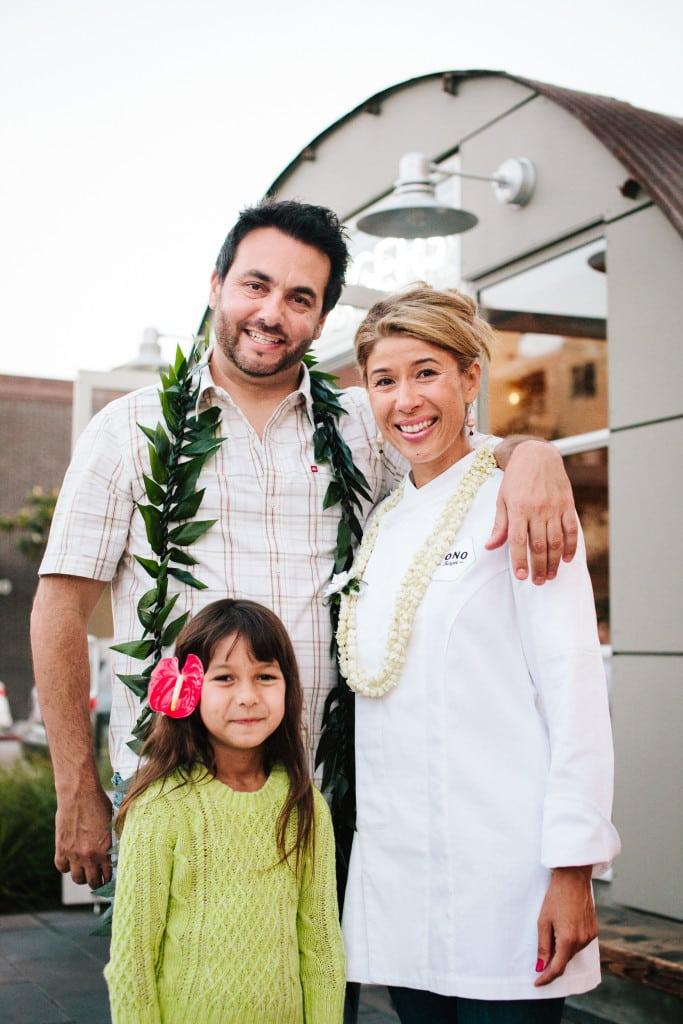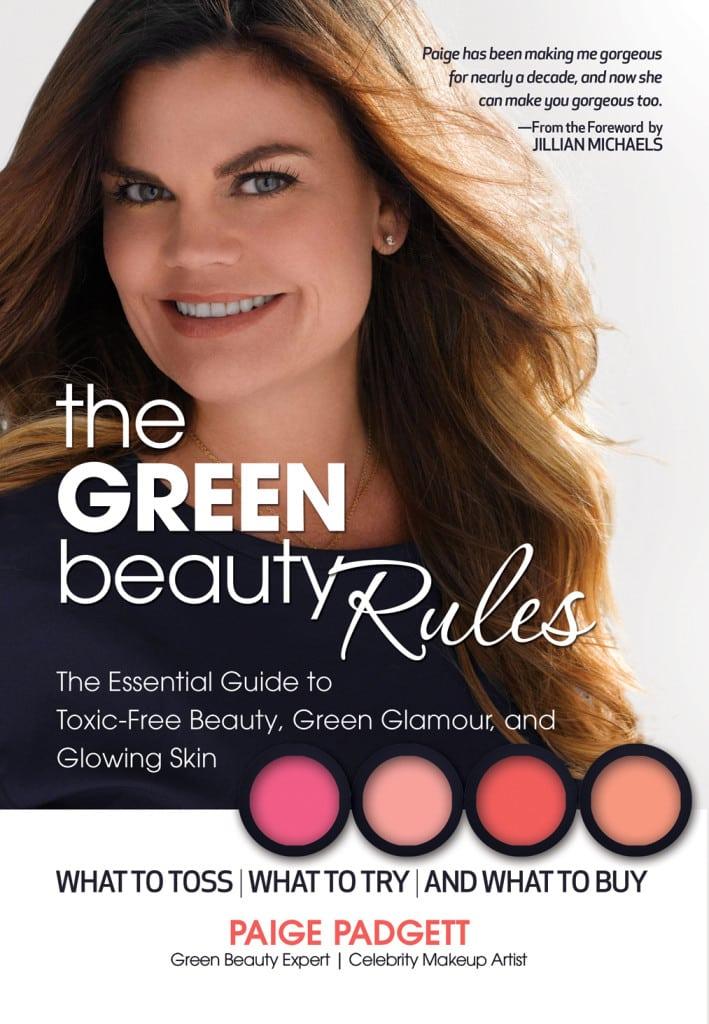
Chef Makani Gerardi, founder of Pono Burger in Santa Monica, makes her own nontoxic cleaning products for the restaurant – and to use at home with her family, husband Jeff Carzino and daughter Phoenix. PHOTO BY GENNIA CUI
We all want to avoid exposing our families to harmful chemicals, whether they come in the form of airborne environmental toxins, pesticides in our food or toxic ingredients in our personal-care and household-cleaning products. The biggest offenders may be petrochemicals, which are derived from petroleum, oil and coal and have been linked to birth defects, endocrine disruption, neurotoxicity and cancer. These widely used offenders can be found in just about any beauty and skincare product you can think of, from moisturizers to shampoos, lipstick and nail polish.
Increasing consumer concern over the past decade or so has brought a wide range of safer products to the market, but a slew of sneaky chemical additives still find their way into many of the products we use every day. Add to that deceptive marketing – using pictures of leaves and flowers on the labels of products containing toxic ingredients, or plastering those labels with the word “natural,” an unregulated term that means virtually nothing – and it can be tough to find toxin-free products for yourself and your children.
If you’re starting to feel overwhelmed, fret not. Paige Padgett, author of The Green Beauty Rules, and other local green experts are happy to share advice on how to avoid harmful ingredients and maintain a healthy, green lifestyle.
Start With the Big Picture
Rachel Avalon, an L.A.-based eco expert and holistic health coach, has been advocating for a cleaner, greener and healthier lifestyle since 2005, and takes a big-picture approach to her mission. “A cleaner, greener and healthier lifestyle is about loving and respecting ourselves, our children, our neighbors, other species and the incredible elements that make Earth so spectacular,” she says. Avalon offers the following practical advice for making healthier, more eco-conscious daily choices:
- Work for a cleaner world. Cut down on overconsumption by buying less, recycling and buying used goods when you can. Resist the temptation to purchase everything your children want. “We can turn things around by helping children to see themselves as planet protectors rather than consumers,” Avalon says.
- Help your body detox. Create a kitchen that supports subtle, daily detoxification, emphasizing organic, plant-based foods as much as possible. Organic foods such as kale, spinach, dandelion greens and broccoli can help clear the body of toxins and protect organs and cells.
- Choose nontoxic cleaners and cosmetics. The Environmental Working Group’s (EWG) Skin Deep database (www.ewg.org/skindeep) is an excellent resource for looking up the ingredients in cosmetics, sunscreen and other skincare products – including those made specifically for babies and mothers-to-be – and evaluating potential health risks associated with those ingredients.
Green Your Beauty Routine

In her book, celebrity makeup artist Paige Padgett shares a wealth of nontoxic product recommendations and beauty advice. PHOTO COURTESY PAIGE PADGETT
Some of the nastiest ingredients to watch out for in any product are petrochemicals, and Padgett says you can spot those by looking out for the prefixes and suffixes “eth,” “butyl,” “ethyl,” methyl,” and “propyl” when you are reading labels.
Padgett is a celebrity makeup artist dedicated to helping her clients look their absolute best without exposing themselves, or their environment, to harmful ingredients. She explains that fillers, colorants and preservatives are so widely used in the cosmetics industry because they are inexpensive to manufacture and help cosmetic products perform the way women want them to.
Fortunately, though, Padgett can direct concerned consumers to plenty of high-performing products without toxic ingredients. Her top five recommendations for eco-friendly cosmetics are:
- Foundation, lip gloss and mascara from W3ll People (www.w3llpeople.com)
- Finishing powder, skin prep and concealer from Hynt Beauty (www.hyntbeauty.com)
- Blush, skincare, hair care and fragrance from Ecco Bella (www.eccobella.com)
- Lipstick and lip liner from Primitive Makeup (www.primitivemakeup.com)
- Touchup stick, brow pencil and facial cleansing balm from Beautycounter (www.beautycounter.com)
Padgett offers a whole slew of additional product recommendations and healthy beauty advice on her website www.paigepadgett.com and in her book.
Padgett knows how difficult it can be to cut out all unhealthy chemicals and ingredients from our beauty routines, so she suggests following the 80/20 rule. Use carefully selected eco-friendly products 80 percent of the time, but allow yourself some wiggle room 20 percent of the time if you want to achieve a certain look or feeling that’s important to you. You might use a chemical hair treatment or a well-loved perfume with synthetic fragrance as long as the rest of your products are nontoxic.
To hold companies accountable for the ingredients they use in their products and bring about positive change in the beauty industry, Padgett advises families to vote with their dollars. “Don’t buy the products with toxic ingredients,” she urges. “Contact the companies and ask them to remove the toxic chemicals. Demand transparency. Jump on board with the EWG [Environmental Working Group]; they offer lots of ways to become an advocate and provide lots of petitions to clean up cosmetics and food.”
Try DIY At Home

L.A.-based holistic health coach Rachel Avalon takes a big-picture approach to a cleaner, greener lifestyle. PHOTO BY HALDANE MORRIS PHOTOGRAPHY
One way to eliminate toxic ingredients is to make products yourself. Makani Gerardi is the owner and head chef of Pono Burger, which has been certified as a Green Business by The Santa Monica Green Business Certification Program (SMGBC). Gerardi strives to use her business as an example of greener practices. “In the restaurant, we try to shift the consciousness a little,” she says. “We know there is a ripple effect in the community around our restaurant. We plant succulents around the restaurant, we pick up any garbage outside our restaurant so that it doesn’t get into our waterways, and we installed low water flow faucets and waterless urinals in the bathroom.”
Gerardi is also a firm believer in making her own naturally derived cleaning products. Growing up, she was taught to clean using vinegar, lemon juice and baking soda. And while it’s easy to buy into the idea that we need heavy-duty solutions to really get items clean, she asserts otherwise. “[At home,] I use fresh lemon juice to clean my cutting boards and I don’t use heavy chemicals,” she says. “I cut things in the order that I’m going to need them. I start with all my vegetables, or my fruit, then I do my meat last and then I clean it with lemon juice. My family doesn’t get sick.”
She also maintains that homemade cleaning products are not only more cost effective than store bought, but can actually work better. “When I take a little bit of baking soda and a scouring pad, that cleans my pans better than any chemical-based cleaner that I’ve had,” she says. “The difference is that [chemical] residue is not getting into my food or our water.”
Gerardi is also quick to point out that starting with safer, organic food means you have a healthier kitchen overall. “When you have the transparency of knowing from the farmers when that vegetable was picked, or when that rancher slaughtered your meat, you have an understanding of what you’re eating. And when you have people who have been trained with proper food handling, then your odds are already working for you,” she says. “But if you’re working with factory meat with pink slime, no wonder you need some scary chemical toxic cocktail to destroy it. That’s creating a war in your kitchen. We want peace in our kitchen.”
For those who want to take the do-it-yourself approach with their household cleaning products, Gerardi shares her favorite simple recipe for an all-purpose cleaning solution:
- ¼ cup white vinegar
- 1 ½ cups water
- 5 drops Tea Tree oil
- 5 drops essential oil of your choice
Note: For a large spray bottle, double the recipe
While it’s easy to be discouraged by the pervasive use of carcinogens and environmental toxins in so many of the products we see on store shelves, take comfort in the fact that knowledge is power. If you do a little research, read your labels and spend your money wisely, you can eliminate petrochemicals and other nasty ingredients from your home – and teach your children to do the same.
Erin Mahoney Harris is a mother of two living in Santa Monica. She’s the author of “Walking LA” and “Visit California Farms,” an agritourism guidebook that will be published in June 2016. You can follow Erin on Twitter at @VisitCaliFarms.






































